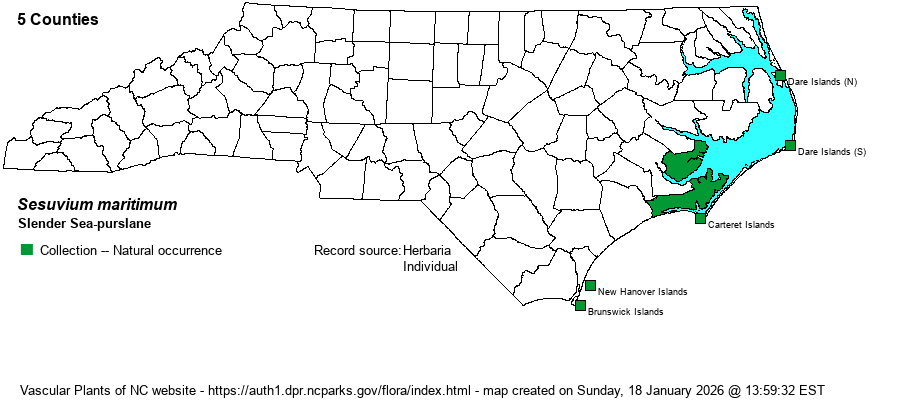| Author | (Walter) Britton, Stearns, & Poggenburg | |
| Distribution | Scattered along the coast. Specimens exist for four of the eight coastal counties, plus one slightly inland.
This is a coastal species, ranging much farther north than S. portulacastrum; occurs from RI south to southern FL and around the coast to southern TX. | |
| Abundance | Rare to sporadically uncommon, as it is an annual and thus numbers vary from site to site from year to year. This is now a State Endangered species. Its State Rank might be closer to S1S2 instead of the NCNHP's S1, but more information on recent populations is needed. Neither species of sea-purslane is well-collected or reported in recent years (except Dare County in 2012-13 and Pamlico in 2021), perhaps owing to difficulty in collecting in protected areas, or simple apathy for small coastal plants. | |
| Habitat | This is a species of sand flats, beaches, sandy damp soil of drawdown zones of ponds and impoundments, and margins of brackish marshes along the coast. The habitats in NC seem to be nearly identical to the other species in the genus. |
| Phenology | Blooms from May to frost, and fruits shortly after flowering. | |
| Identification | This usually is a leaning to somewhat erect herb, with fleshy leaves, not creeping on the ground, rooting at the nodes, and forming mats as does S. portulacastrum. It has opposite to nearly opposite leaves, linear to oblanceolate, about 3/4-inch long and less than 1/4-inch wide. The solitary flowers in the leaf axils are essentially sessile, and white to pale pink, comprised of 5 colored sepals, about 1/3inch across at most. Though this species does tend to sprawl somewhat, it does not root and form mats, and the flower color is paler than in the other species. Also, this species has only 2-3 styles per flower, as opposed to 5 styles per flower in S. portulacastrum. Both of these species are rare, or at least rarely reported, and thus be quite careful in your identification of these two fleshy-leaved species. | |
| Taxonomic Comments | None
| |
| Other Common Name(s) | Small Sea-purslane, Annual Sea-purslane | |
| State Rank | S1 | |
| Global Rank | G5 | |
| State Status | E | |
| US Status | | |
| USACE-agcp | FACW link |
| USACE-emp | FACW link |

